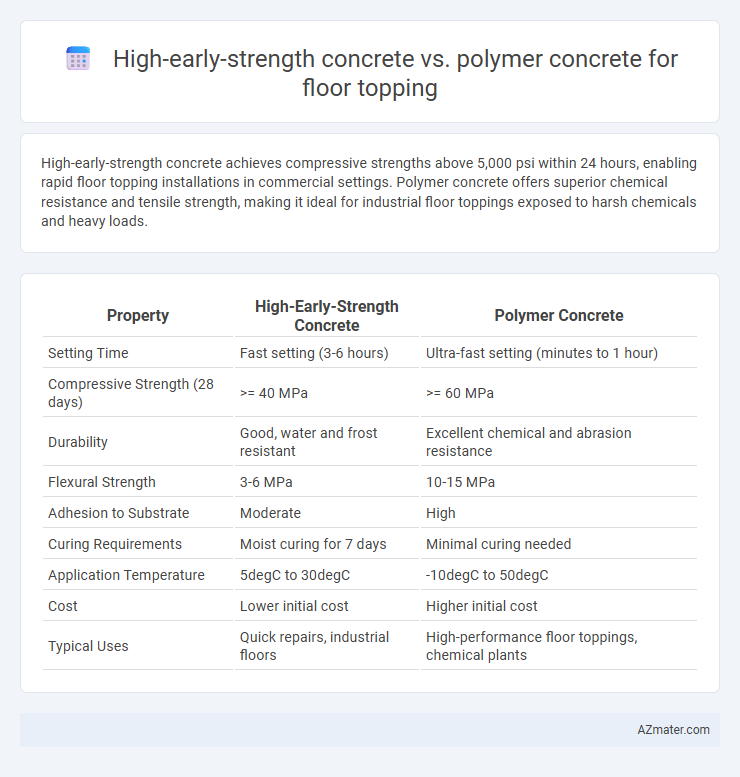High-early-strength concrete achieves compressive strengths above 5,000 psi within 24 hours, enabling rapid floor topping installations in commercial settings. Polymer concrete offers superior chemical resistance and tensile strength, making it ideal for industrial floor toppings exposed to harsh chemicals and heavy loads.
Table of Comparison
| Property | High-Early-Strength Concrete | Polymer Concrete |
|---|---|---|
| Setting Time | Fast setting (3-6 hours) | Ultra-fast setting (minutes to 1 hour) |
| Compressive Strength (28 days) | >= 40 MPa | >= 60 MPa |
| Durability | Good, water and frost resistant | Excellent chemical and abrasion resistance |
| Flexural Strength | 3-6 MPa | 10-15 MPa |
| Adhesion to Substrate | Moderate | High |
| Curing Requirements | Moist curing for 7 days | Minimal curing needed |
| Application Temperature | 5degC to 30degC | -10degC to 50degC |
| Cost | Lower initial cost | Higher initial cost |
| Typical Uses | Quick repairs, industrial floors | High-performance floor toppings, chemical plants |
Introduction to Floor Topping Solutions
High-early-strength concrete offers rapid curing and early load-bearing capacity, making it ideal for fast-track floor topping projects requiring minimal downtime. Polymer concrete provides superior chemical resistance, enhanced durability, and excellent adhesion to substrates, which is advantageous in industrial environments exposed to harsh chemicals or heavy traffic. Selecting between high-early-strength and polymer concrete depends on project-specific demands such as curing time, mechanical performance, and environmental exposure conditions.
Overview of High-Early-Strength Concrete
High-early-strength concrete achieves rapid compressive strength gain within hours, making it ideal for fast-track floor topping applications where quick turnaround is essential. Its composition typically includes high cement content and chemical accelerators to expedite hydration, ensuring early load bearing and reduced downtime. Compared to polymer concrete, high-early-strength concrete offers superior mechanical strength and cost-effectiveness, albeit with longer curing in some conditions.
Understanding Polymer Concrete
Polymer concrete, composed of polymer binders instead of traditional cement, offers superior chemical resistance, rapid curing times, and excellent adhesion for floor toppings in industrial environments. Unlike high-early-strength concrete, which gains strength quickly through accelerated cement hydration, polymer concrete provides enhanced durability, flexibility, and resistance to heavy loads and thermal cycling. Its ability to form a dense, impermeable surface makes it ideal for flooring applications requiring minimal maintenance and long-term performance under harsh conditions.
Composition and Material Properties Comparison
High-early-strength concrete consists primarily of Portland cement, aggregates, and admixtures designed to accelerate hydration, providing rapid strength gain essential for early load-bearing floors. Polymer concrete incorporates resins such as epoxy or polyester as binders instead of traditional cement, resulting in enhanced chemical resistance, reduced permeability, and superior adhesion to substrates. Material properties of high-early-strength concrete emphasize compressive strength development within hours, while polymer concrete excels in tensile strength, flexibility, and durability under harsh chemical or mechanical environments, making each suitable for specific floor topping applications depending on performance requirements.
Installation Methods and Timeframes
High-early-strength concrete offers rapid curing within 4 to 6 hours, allowing floor topping installation to proceed quickly with traditional troweling and finishing techniques, minimizing downtime in industrial environments. Polymer concrete requires surface preparation with primers and often uses injection or spread methods, curing in 2 to 4 hours while providing superior chemical resistance and adhesion on diverse substrates. The installation timeframe of polymer concrete typically extends slightly due to detailed surface preparation but ensures enhanced durability for high-wear flooring applications.
Mechanical Strength and Load-Bearing Capacity
High-early-strength concrete offers rapid compressive strength development, achieving over 20 MPa within 24 hours, making it suitable for fast-track floor topping applications requiring early load-bearing capacity. Polymer concrete provides superior mechanical strength with enhanced tensile and flexural performance, often exceeding 40 MPa in compressive strength while exhibiting excellent chemical resistance and durability under heavy loads. The choice between the two depends on the required curing time and long-term mechanical performance, where polymer concrete excels in load-bearing capacity and resilience, while high-early-strength concrete is preferred for projects demanding quick turnaround.
Durability and Chemical Resistance
High-early-strength concrete offers excellent durability with rapid strength gain, making it suitable for floors that require quick turnaround times and heavy load-bearing capacity. Polymer concrete exhibits superior chemical resistance due to its polymer binder, protecting floor toppings from acids, solvents, and aggressive chemicals often encountered in industrial environments. Combining high-early-strength concrete with polymer additives can enhance both durability and chemical resistance, optimizing performance for demanding floor topping applications.
Cost Analysis and Economic Considerations
High-early-strength concrete offers lower initial material costs and faster curing times that reduce labor expenses and project downtime, making it economically favorable for rapid floor topping applications. Polymer concrete, while featuring higher upfront costs due to specialized resins and additives, provides superior chemical resistance and durability that can decrease long-term maintenance and replacement expenses. Evaluating life-cycle costs, high-early-strength concrete suits budget-sensitive projects with tight schedules, whereas polymer concrete is more cost-effective for floors exposed to aggressive environments requiring longevity.
Typical Applications in Flooring Projects
High-early-strength concrete is commonly used in flooring projects requiring rapid turnaround times, such as commercial warehouses and industrial facilities, due to its quick hardening and load-bearing capacity. Polymer concrete excels in environments exposed to aggressive chemicals or high mechanical stress, making it ideal for pharmaceutical plants, food processing units, and specialized industrial floors. Both materials offer durable solutions, with high-early-strength concrete favored for speed and polymer concrete for enhanced chemical resistance and longevity.
Choosing the Right Floor Topping: Key Factors
High-early-strength concrete offers rapid curing and high load-bearing capacity, making it ideal for fast-track construction and heavy traffic areas. Polymer concrete provides superior chemical resistance, flexibility, and durability against wear, making it suitable for industrial floors exposed to harsh chemicals. Selecting the right floor topping depends on evaluating factors like curing time, load requirements, chemical exposure, and long-term maintenance needs.

Infographic: High-early-strength concrete vs Polymer concrete for Floor topping
 azmater.com
azmater.com